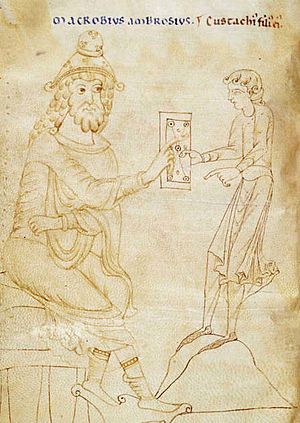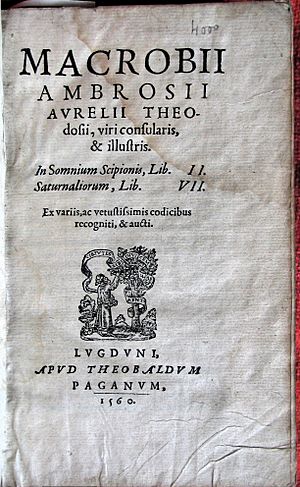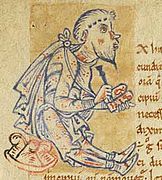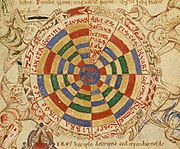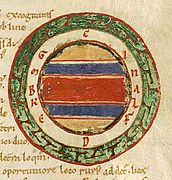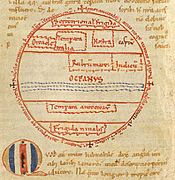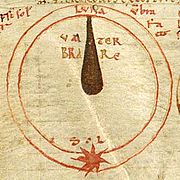Macrobius facts for kids
Macrobius Ambrosius Theodosius, often called Macrobius, was a Roman writer who lived around 400 AD. This was during a time called late antiquity, when the Roman Empire was still very powerful. Both Latin and Greek were widely spoken by important people.
Macrobius is best known for his books. One important book is Commentarii in Somnium Scipionis ("Commentary on the Dream of Scipio"). This book explained the ideas of Neoplatonism to people in the Latin-speaking Western world during the Middle Ages. Another major work is the Saturnalia. It's a collection of facts about ancient Roman religion and old customs. He also wrote a book about Greek and Latin verbs, but it is now lost.
Contents
Who Was Macrobius?
The full name of this writer is "Macrobius Ambrosius Theodosius." This is how his name appears in the oldest copies of his book Saturnalia. It also appears this way in parts of his lost book. Later copies sometimes changed the order of his names.
People like Cassiodorus and Boethius called him "Macrobius Theodosius." During his own lifetime, he was often known simply as "Theodosius."
Macrobius's Life
We don't know much for sure about Macrobius's life. But there are many ideas about him! He wrote in his book Saturnalia that he was "born under a foreign sky." This means he was not born in Italy. Both of his main books are dedicated to his son, Eustachius. Many experts believe he followed the ancient Roman pagan religions, not Christianity.
People have wondered where Macrobius was born. Some think he was Greek or from a Greek-speaking part of the Roman Empire, like Egypt. This is because he knew a lot about Greek literature. Others believe he was more familiar with Latin than Greek. They point out his love for famous Latin writers like Vergil and Cicero. Because of this, some experts think he might have been born in North Africa, which was a Latin-speaking part of the Roman Empire.
Scholars have tried to figure out if Macrobius was a famous official mentioned in old Roman records. These records, called the Codex Theodosianus, mention a Macrobius who was a governor in Spain around 399-400 AD. Another Macrobius was a governor in Africa around 410 AD. There was also a high-ranking official named Macrobius in 422 AD.
However, it's hard to be sure if any of these were the writer Macrobius. For example, one official's full name was "Flavius Macrobius Maximianus," which is different. Another official was a "eunuch," which means he could not have had a son like Eustachius.
Since Macrobius was called vir clarissimus et inlustris (a very famous and important man), it means he held a public office. So, his name should appear in official records. One expert, Alan Cameron, found a "Theodosius" who was a governor in Italy in 430 AD. This Theodosius dealt with matters in Africa, which might connect to Macrobius's possible North African background.
Macrobius's Books
Macrobius wrote two main books that we still have today.
The Saturnalia
Macrobius's Saturnalia is a book with seven parts. It describes conversations that happened during the Roman holiday of Saturnalia. These discussions take place at the home of a man named Vettius Agorius Praetextatus.
The book is full of interesting facts about history, myths, and grammar. It also talks about ancient Roman customs. It's like a series of talks among smart people at a pretend dinner party.
Commentary on the Dream of Scipio
This book explains a part of Cicero's famous work, De re publica, called Somnium Scipionis ("The Dream of Scipio"). In this dream, a Roman general sees the Earth from space. He learns about the universe and the importance of living a good life.
Macrobius's commentary helped people in the Middle Ages understand complex ideas about the universe and philosophy. It was a very important source for the ideas of Neoplatonism, which was a way of thinking based on the ancient Greek philosopher Plato.
Macrobius's Legacy
Macrobius's name lives on in space and on Earth!
- A large crater on the Moon is named after him.
- There is also a place called Macrobius Cove in Antarctica named in his honor.
Gallery
Cicero's Dream of Scipio described the Earth as a globe of insignificant size in comparison to the remainder of the cosmos. Many early medieval manuscripts of Macrobius include maps of the Earth, including the antipodes, zonal maps showing the Ptolemaic climates derived from the concept of a spherical Earth and a diagram showing the Earth (labeled as globus terrae, the sphere of the Earth) at the center of the hierarchically ordered planetary spheres.
Images from a 12th-century manuscript of Macrobius's Commentarii in Somnium Scipionis (Parchment, 50 ff.; 23.9 × 14 cm; Southern France). Date: ca. 1150. Source: Copenhagen, Det Kongelige Bibliotek, ms. NKS 218 4°.
-
The Universe, the Earth in the centre, surrounded by the classical planets, including the sun and the moon, within the zodiacal signs.
-
Sketch map showing the inhabited northern region separated from the antipodes by an imagined ocean at the equator.
See also
 In Spanish: Macrobio para niños
In Spanish: Macrobio para niños
- Allegory in the Middle Ages
- Early world maps
- Mappa mundi


